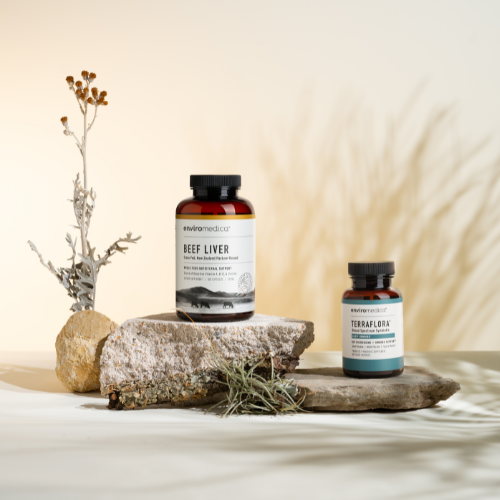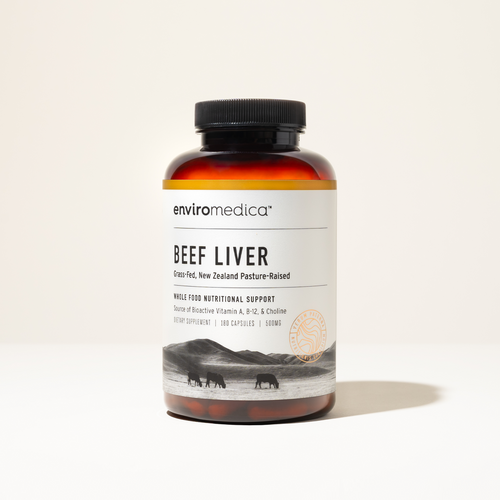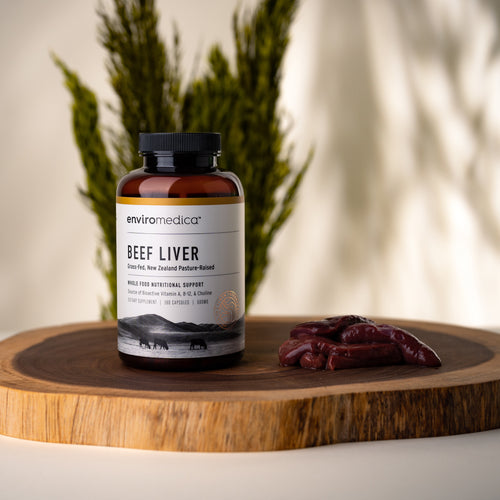Are you prepared to look toward your ancestors for clues to vitality? To heal from nutrient deficiencies caused by a modern diet and to gain energy and health naturally? You might find yourself reading this page because you’ve learned about the nutritional benefits of consuming organ meats and seek a familiar way to incorporate them into your diet. One familiar way is to begin with beef liver.
Beef liver is often called the superfood of the animal kingdom because it is one of the most nutrient dense foods on Earth. Liver is an excellent source of protein, the single greatest source of preformed vitamin A, contains abundant bioavailable B12 and B-complex vitamins, choline, biotin, iron, copper, zinc, folate, and contains all of the fat soluble vitamins (A, D, E, K).1 2 This natural whole food was even used to therapeutically treat pernicious anemia.3 4 The nutrients that comprise beef liver are the synergistic building blocks of metabolic, immune, liver, skin, eye, reproductive, and mental health.5 6 7 8 9 These vital nutrients are also those that tend to be deficient in the bodies of our western population.10 11 12 13
If these facts alone aren’t enough to inspire you to incorporate beef liver into your diet, read on to learn more about the nutritional value of beef liver, why it is always important to know the source of any liver you consume, the function of the liver and whether or not it is a toxic storage organ, and how much beef liver is recommended in your diet to reap the seemingly countless nutritional rewards.
Nutritional Value
Beef liver from naturally raised cows is an incredible source of nutrition.14 15 It is a nutrient dense source of the vitamins and minerals modern humans are most likely to be deficient in.16 17 18 19 It’s as if beef liver was designed by nature for our benefit.
As mentioned above, beef liver is an enriched source of preformed vitamin A (retinol) containing synergistic amounts of all other fat-soluble vitamins (D, E, and K). It contains abundant bioavailable vitamin B12 and the suite of B-complex vitamins including folate. It is an important source of choline and contains a number of bioavailable micronutrients including iron, copper, phosphorus, potassium, magnesium, and manganese. Additionally, grass-fed beef liver has a favorable essential fatty acid profile. (Tables 1 & 2)20 21 22 23
Vitamin A deserves a special overview with respect to beef liver. Fat-soluble dietary vitamin A is derived from both preformed vitamin A and provitamin A. Preformed vitamin A, known as retinol, is sourced from animals. Provitamin A is derived from plant pigments collectively known as carotenoids such as beta-carotene.24 Provitamin A is a precursor to vitamin A, it requires conversion to retinol in the body in order to be utilized.25 Furthermore, the absorption efficiency of preformed vitamin A is on the order of 75%-100%, while the absorption efficiency for provitamin A varies from only 3% to 90% depending on the genetics of the individual.26 27 28 In other words, preformed vitamin A is both ready for your body to use and easy to assimilate. Provitamin A requires additional processing for use in the body and even then there is a chance that it will not be absorbed well.
As you can see in Table 1, a 100 g (~3.5 oz) serving of beef liver contains nearly 17000 IU of vitamin A. Nearly all of this is in the form of preformed vitamin A, or retinol.29 30 Preformed vitamin A supports a healthy immune system,31 32 liver function,33 eye health,34 reproductive health,35 and genetic health36. Vitamin A (retinoids) has been found to induce apoptosis, or cellular death, in prostate cancer cells.37 Vitamin A is also correlated to skin health. Skin conditions such as keratosis pilaris, psoriasis, and acne have been correlated to vitamin A deficiency.38 39 For many people, vitamin A sufficiency and the health benefits that come with it depend upon consumption of preformed vitamin A (retinol), and the best source happens to be liver.
Despite the fact that vitamin A in beef liver is primarily preformed, it is interesting to compare the amount of preformed and provitamin A in the liver of grass-fed vs. conventionally raised cows. Just as you might suspect, a cow free to graze on pasturelands full of beta-carotene, produces a liver higher in beta-carotene compared to the grain-fed cow.40 (Figure 1) Carotenoids, particularly if they are efficiently converted to vitamin A, are documented to be important for cellular health, and preventative for cancer, eye, and skin diseases.41 42 43 44
Essential fatty acids are those derived exclusively through diet, they are not manufactured by the body.45 They include omega-6 and omega-3 fatty acids. When we eat a diet exclusively from nature as our ancestors did, we naturally receive an omega-6:omega-3 ratio of around 1:1. Compare this to a modern diet rich in grains and industrial seed-oils (similar to the diet of conventionally raised cows) where the average person receives an omega-6:omega-3 ratio of 20:1.46 47 This unnatural fatty acid ratio is interpreted by the body as highly inflammatory and promotes disease. Table 2 shows a comparison of the fatty acid composition of liver from grass-fed steer and ‘concentrate’ (barley and soya 4:1, labeled ‘grain’ on the table) fed bulls.48 Notice the omega-3 (n-3) values are higher in the liver from grass-fed cows, and the omega-6 (n-6) values are higher in the liver from grain-fed cows. Enser et al. (1998) note that the liver from grass-fed cows has a very favorable omega-6:omega-3 ratio and point out that the grass-fed liver also contains a high concentration of DHA and EPA, important natural building blocks for mental health.49 Liver from grass-fed cows for the win!
Table 1. Beef Liver Nutritional Data
| per 100g | Liver | ||||
| beef, raw | |||||
| Carbohydrates | g | 3.9 | |||
| Fats | g | 3.6 | |||
| saturated | g | 1.2 | |||
| monounsaturated | g | 0.5 | |||
| polyunsaturated | g | 0.5 | |||
| Protein | g | 20.4 | |||
| Vitamin A | IU | 16899.0 | |||
| Vitamin C | mg | 1.3 | |||
| Vitamin D | IU | 16.0 | |||
| Vitamin E | mg | 0.4 | |||
| Vitamin K | mg | 2.8 | |||
| Thiamin | mg | 0.2 | |||
| Riboflavin | mg | 2.8 | |||
| Niacin | mg | 13.2 | |||
| Vitamin B6 | mg | 1.1 | |||
| Folate | mcg | 290.0 | |||
| Vitamin B12 | mcg | 59.3 | |||
| Pantothenic Acid | mg | 7.2 | |||
| Choline | mg | 333.0 | |||
| Calcium | mg | 5.0 | |||
| Iron | mg | 4.9 | |||
| Magnesium | mg | 18.0 | |||
| Phosphorus | mg | 387.0 | |||
| Potassium | mg | 313.0 | |||
| Sodium | mg | 69.0 | |||
| Zinc | mg | 4.0 | |||
| Copper | mg | 9.8 | |||
| Manganese | mg | 0.3 | |||
| Selenium | mcg | 39.7 | |||
| Nutrition data from http://nutritiondata.self.com/ | |||||
Table 2. Fatty Acid Composition of Grass-fed vs. Grain-fed Cow Liver
| mg per 100g liver | |||||
| Fatty Acid | Grass | Grain | SED | Significance | |
| 14:0 myristic | 21.7 | 36.3 | 4.73 | <0.005 | |
| 16:0 palmitic | 472 | 544 | 56.9 | NS | |
| 16:1 cis | 81.2 | 86.5 | 9.46 | NS | |
| 18.0 stearic | 857 | 909 | 24.0 | <0.05 | |
| 18:1 trans | 63.9 | 57.9 | 7.05 | NS | |
| 18:1 n-9 oleic | 440 | 524 | 48.7 | NS | |
| 18:1 n-7 cis vaccenic | 28.9 | 55.5 | 2.42 | <0.001 | |
| 18:2 n-6 linoleic | 172 | 444 | 17.6 | <0.0001 | |
| 18:3 n-6 v-linolenic | 7.0 | 8.0 | .084 | NS | |
| 18:3 n-3 a-linolenic | 92 | 31.8 | 9.15 | <0.0001 | |
| 20:2 n-6 | 3.9 | 7.8 | 0.43 | <0.0001 | |
| 20:3 n-6 | 90 | 135 | 6.44 | <0.0001 | |
| 20:3 n-3 | 4.5 | 1.4 | 0.48 | <0.0001 | |
| 20:4 n-6 arachidonic | 194 | 270 | 7.46 | <0.0001 | |
| 20:4 n-3 | 68 | 11 | 4.70 | <0.0001 | |
| 20:5 n-3 EPA | 151 | 16.9 | 6.16 | <0.0001 | |
| 22:4 n-6 | 16.1 | 92.0 | 3.23 | <0.0001 | |
| 22:5 n-3 | 283 | 108 | 12.3 | <0.0001 | |
| 22:6 n-3 DHA | 83 | 32 | 4.28 | <0.0001 | |
| Total | 3445 | 3660 | 176 | NS | |
| Nutrition data from Enser et al, 1998 | |||||
Figure 1. Vitamin A content of liver and muscle from grass-fed and grain-fed cows. Note the change in scale between provitamin A and preformed A. Adapted from Darwish et al, 2015.
You can see how the nutrient content of beef liver is intimately associated to the way the animal was raised. Perhaps you also see how your nutrient sufficiency is related to the way you are raised.
The Importance of Source
Conventionally raised cows are fed grain, a food that is not natural to the cow. While grain does manage to increase the size and economic value of the animal, it does not support its health. You might be surprised to learn that ~12% to 32% (and up to 95% depending on the source) of animals from grain-fed feedlots have abscesses in their liver at a grade high enough to condemn them.50 51 52 The incidence of liver abscess is proportional to the amount of grain in the diet, with increasing ‘roughage’ showing a decrease in abscess rate.53 Liver abscess is correlated to an unnatural diet and consequently to the presence of a distinct bacterial flora. The abscess ‘prevention’ strategy has been to add antimicrobials to the feed, further challenging the liver. While detoxification processes in the liver do amazing things under natural circumstances, meat from animals farmed for sale in the grocery store are not raised naturally.
A healthy cow with a healthy liver is raised on its natural diet, grass. Optimally, this grassland is 100% natural, grown without the use of fertilizers, herbicides, or genetic modification. This improves the cow’s ecosystem and reduces potential chronic toxins in its environment.
Notably however, an animal raised on grassland downwind of industrial contaminants can have compromised health. Koréneková et al, (2002) report increased concentrations of heavy metals in the muscle and liver tissue of cows raised near a metallurgical plant.54 This highlights the importance of large-scale ecological considerations when raising animals for human consumption.
One such large-scale ecological consideration is the diversity of grasslands that cows graze upon. Just as diversity in the human diet is key to receiving optimal nutrition, the phytochemical diversity of grassland is shown to strengthen the immune system, metabolism, and reproductive health of animals that graze on them.55 French et al. (2018) report data showing native high-diversity grasslands contain plants with natural antimicrobials and anthelmintic compounds (phytochemicals). The authors suggest we use these grasses, ironically, to supplement conventionally raised livestock feed to “preserve the efficacy of last-resort drugs”.
Taking environment, climate, ecology, sustainability, and animal welfare into consideration, the best sources for grass-fed beef are the GMO-free pastures of New Zealand.
It is possible for cows to graze on native New Zealand pasture year-round given the sunny, mild climate.56 The climate and year-round food source provide the cows with a constant source of omega-3 and ultimately, their livers are among the richest source of omega-3 docosapentaenoic acid (DPA), whereas the livers from US beef have relatively trace amounts.57 58
New Zealand has some of the strictest animal welfare laws in the world outlined in the Animal Welfare Act of 1999.59 Indicators for superior animal welfare include: recognition of animal sentience, laws against animal suffering, and protections for farmed animals, animals in captivity, companion animals, recreational animals, animals used for research, and wild animals.60 61 New Zealand is recognized as one of the top-rated countries for animal welfare globally by the World Animal Protection organization.62
In addition, New Zealand has enacted the Biosecurity Act of 1993.63 This legislation elevates the prevention and management of risk from pests and disease to protect New Zealand’s ecosystem (including the economy, environment, people, and values) to a governmental priority.64 This Act has been amended to strengthen it going forward in an initiative called ‘Biosecurity 2025’. The vision is to enlist all New Zealanders in the effort to manage pests and diseases.65 These efforts make outbreaks like ‘mad cow disease’ virtually nonexistent in New Zealand and provide its people with assurance that swift action will be taken to eradicate pathogenic organisms in the event that they cross the boundary into their country.
Where there are animal welfare efforts, there are healthy, naturally-raised cows that are the source of nutrient-rich organs and meats.
But Isn’t Beef Liver Toxic?
The mammalian liver has many important functions in the body: it holds nutrient reserves,66 regulates metabolic pathways for carbohydrates, proteins, and fats,67 aids in fat digestion,68 assists in innate and adaptive immunity,69 70 neutralizes toxins,71 makes cholesterol,72 73produces red blood cells and factors for blood clotting,74 it makes lipoproteins (59), produces ketone bodies as an alternative fuel to glucose75 and it converts thyroid hormones into something the body can use. 76
Adding to its already powerful profile, the liver is the only organ in the body that can actually regenerate.77 It has a great capacity to remodel itself and heal from insults. Michalopoulous (2007) reports that a human liver can fully regenerate in 8-15 days after a procedure called a 2/3 partial hepatectomy (PHx). Despite its remarkable regenerative capacity, a hepatocyte (liver cell) will live for 200-300 days.78
The liver is widely known for its ability to detoxify the body, leaving many people to wonder why on earth anyone would recommend eating liver? Isn’t it an organ that filters the blood and is destined to be filled with toxic compounds? Rest assured, the liver is not designed to work like a physical sponge that soaks up toxins. It is designed to work more like a biochemical filter. It functions in two phases, first to neutralize toxins with enzymes making them less harmful (Phase I detoxification) and second, to make the neutralized toxins water soluble enabling excretion from the body (Phase II detoxification).79
That said, while the liver is not designed to store toxins, it is a tissue that will reflect the health and environment of the entire animal.
How Much Liver Should You Eat?
Given its superfood status when sourced responsibly, can you have too much of a good thing? There are several things to take into consideration when determining how much liver to eat, including genetics, your age, gender, reproductive status, and overall nutrient intake. While you won’t have to worry about vitamin A deficiency when it comes to liver consumption, there is the possibility of toxicity, or hypervitaminosis A.80
The liver has impressive functions and an impressive size to show for it. The liver is the cow’s largest internal organ, comprising 2-3% of the entire dressed mass of the animal,81 82 Assuming the dressed weight is 600 pounds, it can have a liver that weighs about 12 pounds!
From an ancestral perspective, you look to nature to guide you as to how much liver to eat. Imagine your tribe of 25-35 people83 hunted a 1200 pound animal (live weight) with ~25 pounds of organs including about ~12 pounds of liver. Surely you will share this animal and the organ meats/liver will go to the people who need those nutrients the most; the hunters, the pregnant/nursing women,84 the immune compromised – whomever needs them the most at the time. You might get a fraction of this 12-lb liver, divided among many. From this perspective, you can reasonably estimate a few ounces of liver.
In fact, the current recommendation for the amount of liver to eat to remain nutrient sufficient without fear of vitamin A toxicity is 4-8 oz per week.85
Vitamin A toxicity, or hypervitaminosis A,86 87 can be acute with a one-time dose of >500,000 IU, or chronic with a wider range of supplementary doses daily over the course of months or years, depending on the individual (12,000 – 500,000 IU/day).88 Vitamin A toxicity can cause changes to your skin, your vision, headaches, skeletal pain, or possibly death.89 Although there are reports of arctic explorers falling ill to hypervitaminosis A by eating polar bear liver,90 today it is largely found associated with high dose vitamin A supplementation without synergistic amounts of vitamin D consumed,91 92 That said, hypervitaminosis A is easy to avoid by: getting your vitamin A from whole foods containing vitamin D rather than through isolated supplementation, and by conservatively limiting beef liver intake to about 4-8 oz per week.93
Adding Beef Liver to Your Diet
Beef liver has a distinctive, acquired taste that is enjoyed by some, tolerated by others, and completely out of the question for many. The texture of raw beef liver is relatively smooth and gelatinous. Pureed raw liver (to hide in ground beef or to make a pâté) is a bit coagulated in appearance. When cooked by itself, it is dense and a bit grainy. It tastes slightly metallic, rich, and well, livery.
The distinct flavor of beef liver can be masked somewhat by various processing techniques. Soaking liver in milk for a couple of hours prior to cooking it is said to neutralize the flavor. Adding fresh lemon juice is another way to balance the flavor. Mixing beef liver with other meats such to make liverwurst, braunschweiger, or sausage creates an entirely different experience and changes the flavor drastically.
Historically and anecdotally, there is precedent for eating raw liver to reap nutritional benefits.94 Gerson Therapy, a cancer therapy utilizing dietary and nutrient strategies as a pathway to treat the whole body for cancer, once had raw liver extract as part of the protocol.95 Raw liver was once used to treat pernicious anemia96. Traditionally, hunter-gatherer populations consumed the organs of their prey raw.97 Scientifically, there may be precedent for considering raw liver over cooked liver, particularly due to changes in amino acid structure and the creation of advanced glycation end products.98 Raw liver can be considered quite a delicacy when prepared properly such as for pâté or fois gras. Another rather adventurous option for adding raw beef liver to your diet is to freeze it in small tablespoon-sized portions and add it to smoothies.
If you are convinced of the nutritional powerhouse that is beef liver, but remain unconvinced that you will find a healthy source, prepare it on your own, or enjoy eating it at all, you’re in luck. You can supplement with freeze-dried raw beef liver capsules to reap its nutritional benefit. The freeze-drying process removes water, naturally preserves the liver, and has been shown to both retain and concentrate bioactive compounds of whole foods with negligible nutrient loss.
Now it’s time to take your first step and see if you feel the difference in your health by adding beef liver to your diet. How will you try it first?
Enviromedica Beef Liver
Enviromedica Beef Liver is sourced exclusively from grass-fed livestock raised on the rich open pastures of New Zealand, where animal husbandry practices are globally considered as second to none. Fresh livers are gently freeze-dried to preserve biological activity and nutrient content.
References
-
1. Beef, variety meats and by-products, liver, raw Nutrition Facts & Calories [Online]. SELFNutritionData: know what you eat. Available: http://nutritiondata.self.com/facts/beef-products/3468/2
- 2. >Staggs, C. G., Sealey, W. M., Mccabe, B. J., Teague, A. M. & Mock, D. M. 2004. Determination of the biotin content of select foods using accurate and sensitive HPLC/avidin binding. J Food Compost Anal, 17, 767-776.
- 3. Kumar, N., Boes, C. J. & Samuels, M. A. 2006. Liver therapy in anemia: a motion picture by William P. Murphy. Blood, 107, 4970.
- 4. Sinclair, L. 2008. Recognizing, treating and understanding pernicious anaemia. J R Soc Med, 101, 262-4.
- 5. Jacobs, D. R., Jr., Gross, M. D. & Tapsell, L. C. 2009. Food synergy: an operational concept for understanding nutrition. Am J Clin Nutr, 89, 1543S-1548S.
- 6. Price, W. A. 1939. Nutrition and physical degeneration; a comparison of primitive and modern diets and their effects, New York, London,, P.B. Hoeber.
- 7. Calton, J. B. 2010. Prevalence of micronutrient deficiency in popular diet plans. J Int Soc Sports Nutr, 7, 24.
- 8. Ward, E. 2014. Addressing nutritional gaps with multivitamin and mineral supplements. Nutr J, 13, 72.
- 9. Hanson, M. A., Bardsley, A., De-Regil, L. M., Moore, S. E., Oken, E., Poston, L., Ma, R. C., Mcauliffe, F. M., Maleta, K., Purandare, C. N., Yajnik, C. S., Rushwan, H. & Morris, J. L. 2015. The International Federation of Gynecology and Obstetrics (FIGO) recommendations on adolescent, preconception, and maternal nutrition: “Think Nutrition First”. Int J Gynaecol Obstet, 131 Suppl 4, S213-53.
- 10. Calton, J. B. 2010. Prevalence of micronutrient deficiency in popular diet plans. J Int Soc Sports Nutr, 7, 24.
- 11. Troesch, B., Biesalski, H. K., Bos, R., Buskens, E., Calder, P. C., Saris, W. H., Spieldenner, J., Verkade, H. J., Weber, P. & Eggersdorfer, M. 2015. Increased Intake of Foods with High Nutrient Density Can Help to Break the Intergenerational Cycle of Malnutrition and Obesity. Nutrients, 7, 6016-37.
- 12. Gernand, A. D., Schulze, K. J., Stewart, C. P., West, K. P., Jr. & Christian, P. 2016. Micronutrient deficiencies in pregnancy worldwide: health effects and prevention. Nat Rev Endocrinol, 12, 274-89.
- 13. Bird, J. K., Murphy, R. A., Ciappio, E. D. & Mcburney, M. I. 2017. Risk of Deficiency in Multiple Concurrent Micronutrients in Children and Adults in the United States. Nutrients, 9.
- 14. Enser, M., Hallett, K. G., Hewett, B., Fursey, G. A., Wood, J. D. & Harrington, G. 1998. The polyunsaturated fatty acid composition of beef and lamb liver. Meat Sci, 49, 321-7.
- 15. Byelashov, O. A., Sinclair, A. J. & Kaur, G. 2015. Dietary sources, current intakes, and nutritional role of omega-3 docosapentaenoic acid. Lipid Technol, 27, 79-82.
- 16. Calton, J. B. 2010. Prevalence of micronutrient deficiency in popular diet plans. J Int Soc Sports Nutr, 7, 24.
- 17. Troesch, B., Biesalski, H. K., Bos, R., Buskens, E., Calder, P. C., Saris, W. H., Spieldenner, J., Verkade, H. J., Weber, P. & Eggersdorfer, M. 2015. Increased Intake of Foods with High Nutrient Density Can Help to Break the Intergenerational Cycle of Malnutrition and Obesity. Nutrients, 7, 6016-37.
- 18. Gernand, A. D., Schulze, K. J., Stewart, C. P., West, K. P., Jr. & Christian, P. 2016. Micronutrient deficiencies in pregnancy worldwide: health effects and prevention. Nat Rev Endocrinol, 12, 274-89.
- 19. Bird, J. K., Murphy, R. A., Ciappio, E. D. & Mcburney, M. I. 2017. Risk of Deficiency in Multiple Concurrent Micronutrients in Children and Adults in the United States. Nutrients, 9.
- 20. Beef, variety meats and by-products, liver, raw Nutrition Facts & Calories [Online]. SELFNutritionData: know what you eat. Available: http://nutritiondata.self.com/facts/beef-products/3468/2
- 21. Enser, M., Hallett, K. G., Hewett, B., Fursey, G. A., Wood, J. D. & Harrington, G. 1998. The polyunsaturated fatty acid composition of beef and lamb liver. Meat Sci, 49, 321-7.
- 22. Matschiner, J. T., Taggart, W. V. & Amelotti, J. M. 1967. The vitamin K content of beef liver. Detection of a new form of vitamin K. Biochemistry, 6, 1243-8.
- 23. Dhiman, T. R., Nam, S. H. & Ure, A. L. 2005. Factors affecting conjugated linoleic acid content in milk and meat. Crit Rev Food Sci Nutr, 45, 463-82.
- 24. Green, A. S. & Fascetti, A. J. 2016. Meeting the Vitamin A Requirement: The Efficacy and Importance of beta-Carotene in Animal Species. ScientificWorldJournal, 2016, 7393620.
- 25. Harrison, E. H. 2012. Mechanisms involved in the intestinal absorption of dietary vitamin A and provitamin A carotenoids. Biochim Biophys Acta, 1821, 70-7.
- 26. Reboul, E. 2013. Absorption of vitamin A and carotenoids by the enterocyte: focus on transport proteins. Nutrients, 5, 3563-81.
- 27. Borel, P., Lietz, G., Goncalves, A., Szabo De Edelenyi, F., Lecompte, S., Curtis, P., Goumidi, L., Caslake, M. J., Miles, E. A., Packard, C., Calder, P. C., Mathers, J. C., Minihane, A. M., Tourniaire, F., Kesse-Guyot, E., Galan, P., Hercberg, S., Breidenassel, C., Gonzalez Gross, M., Moussa, M., Meirhaeghe, A. & Reboul, E. 2013. CD36 and SR-BI are involved in cellular uptake of provitamin A carotenoids by Caco-2 and HEK cells, and some of their genetic variants are associated with plasma concentrations of these micronutrients in humans. J Nutr, 143, 448-56.
- 28. Borel, P. & Desmarchelier, C. 2017. Genetic Variations Associated with Vitamin A Status and Vitamin A Bioavailability. Nutrients, 9.
- 29. Vitamin A: Fact Sheet for Health Professionals [Online]. National Institutes of Health: Office of Dietary Supplements. Available: https://ods.od.nih.gov/factsheets/VitaminA-HealthProfessional/#en38 [Accessed].
- 30. Vitamin A: Fact Sheet for Consumers [Online]. National Institutes of Health: Office of Dietary Supplements. Available: https://ods.od.nih.gov/factsheets/VitaminA-Consumer/ [Accessed].
- 31. Blomhoff, H. 2004. Vitamin A regulates proliferation and apoptosis of human T- and B-cells. Biochemical Society Transactions, 32, 982-984.
- 32. Parker, G. A. & Picut, C. A. 2005. Liver immunobiology. Toxicol Pathol, 33, 52-62.
- 33. Freund, C. & Gotthardt, D. N. 2017. Vitamin A deficiency in chronic cholestatic liver disease: Is vitamin A therapy beneficial? Liver Int, 37, 1752-1758.
- 34. Hobbs, R. P. & Bernstein, P. S. 2014. Nutrient Supplementation for Age-related Macular Degeneration, Cataract, and Dry Eye. J Ophthalmic Vis Res, 9, 487-93.
- 35. Clagett-Dame, M. & Knutson, D. 2011. Vitamin A in reproduction and development. Nutrients, 3, 385-428.
- 36. Borel, P. & Desmarchelier, C. 2017. Genetic Variations Associated with Vitamin A Status and Vitamin A Bioavailability. Nutrients, 9.
- 37. Zhang, X. K. 2002. Vitamin A and apoptosis in prostate cancer. Endocr Relat Cancer, 9, 87-102.
- 38. Park, K. 2015. Role of micronutrients in skin health and function. Biomol Ther (Seoul), 23, 207-17.
- 39. Gruber, R., Sugarman, J. L., Crumrine, D., Hupe, M., Mauro, T. M., Mauldin, E. A., Thyssen, J. P., Brandner, J. M., Hennies, H. C., Schmuth, M. & Elias, P. M. 2015. Sebaceous gland, hair shaft, and epidermal barrier abnormalities in keratosis pilaris with and without filaggrin deficiency. Am J Pathol, 185, 1012-21.
- 40. Darwish, W. S., Ikenaka, Y., Morshdy, A. E., Eldesoky, K. I., Nakayama, S., Mizukawa, H. & Ishizuka, M. 2016. beta-carotene and retinol contents in the meat of herbivorous ungulates with a special reference to their public health importance. J Vet Med Sci, 78, 351-4.
- 41. Darwish, W. S., Ikenaka, Y., Morshdy, A. E., Eldesoky, K. I., Nakayama, S., Mizukawa, H. & Ishizuka, M. 2016. beta-carotene and retinol contents in the meat of herbivorous ungulates with a special reference to their public health importance. J Vet Med Sci, 78, 351-4.
- 42. Fiedor, J. & Burda, K. 2014. Potential role of carotenoids as antioxidants in human health and disease. Nutrients, 6, 466-88.
- 43. Evans, J. A. & Johnson, E. J. 2010. The role of phytonutrients in skin health. Nutrients, 2, 903-28.
- 44. Johnson, E. J. 2002. The role of carotenoids in human health. Nutr Clin Care, 5, 56-65.
- 45. Di Pasquale, M. G. 2009. The essentials of essential fatty acids. J Diet Suppl, 6, 143-61.
- 46. Simopoulos, A. P. 2002. The importance of the ratio of omega-6/omega-3 essential fatty acids. Biomed Pharmacother, 56, 365-79.
- 47. Simopoulos, A. P. 2016. An Increase in the Omega-6/Omega-3 Fatty Acid Ratio Increases the Risk for Obesity. Nutrients, 8, 128.
- 48. Enser, M., Hallett, K. G., Hewett, B., Fursey, G. A., Wood, J. D. & Harrington, G. 1998. The polyunsaturated fatty acid composition of beef and lamb liver. Meat Sci, 49, 321-7.
- 49. Horrocks, L. A. & Yeo, Y. K. 1999. Health benefits of docosahexaenoic acid (DHA). Pharmacol Res, 40, 211-25.
- 50. Nagaraja, T. G. & Chengappa, M. M. 1998. Liver abscesses in feedlot cattle: a review. J Anim Sci, 76, 287-98.
- 51. Nagaraja, T. G. & Lechtenberg, K. F. 2007. Liver abscesses in feedlot cattle. Vet Clin North Am Food Anim Pract, 23, 351-69, ix.
- 52. Roberts, J. L. 1982. The prevalence and economic significance of liver disorders and contamination in grain-fed and grass-fed cattle. Aust Vet J, 59, 129-32.
- 53. Nagaraja, T. G. & Chengappa, M. M. 1998. Liver abscesses in feedlot cattle: a review. J Anim Sci, 76, 287-98.
- 54. Koréneková, B., Skalicka, M. & Naï, P. 2002. Concentration of some heavy metals in cattle reared in the vicinity of a metallurgic industry.
- 55. French, K. E., Harvey, J. And Mccullagh, J.S.O. 2018. Targeted and Metabolic Profiling of Wild Grassland Plants identifies Antibiotic and Anthelmintic Compounds Targeting Pathogen Physiology, Metabolism and Reproduction. Scientific Reports, 8, 1-10.
- 56. Pasture management in New Zealand [Online]. Progressive Forage. Available: https://www.progressiveforage.com/forage-production/producer-features/pasture-management-in-new-zealand [Accessed].
- 57. Byelashov, O. A., Sinclair, A. J. & Kaur, G. 2015. Dietary sources, current intakes, and nutritional role of omega-3 docosapentaenoic acid. Lipid Technol, 27, 79-82.
- 58. Full Report (All Nutrients): 13325, Beef, variety meats and by-products, liver, raw. United States Department of Agriculture Agricultural Research Service, National Nutrient Database for Standard Reference.
- 59. 1999. Animal Welfare Act 1999 [Online]. New Zealand: Parliamentary Counsel Office. Available: http://www.legislation.govt.nz/act/public/1999/0142/latest/DLM49664.html [Accessed].
- 60. World Animal Protection [Online]. Available: https://www.worldanimalprotection.org/our-work/help-protect-animals-globally/review-animal-welfare-standards-around-world [Accessed].
- 61. World Animal Protection – Rankings [Online]. Available: https://api.worldanimalprotection.org/ [Accessed].
- 62. World Animal Protection [Online]. Available: https://www.worldanimalprotection.org/our-work/help-protect-animals-globally/review-animal-welfare-standards-around-world [Accessed].
- 63. 1993. Biosecurity Act 1993 [Online]. New Zealand: Parliamentary Counsel Office. Available: http://www.legislation.govt.nz/act/public/1993/0095/164.0/DLM314623.html [Accessed].
- 64. Law & Policy: Biosecurity [Online]. Ministry for Primary Industries. Available: https://www.mpi.govt.nz/law-and-policy/legal-overviews/biosecurity/ [Accessed].
- 65. Biosecurity 2025 [Online]. Ministry for Primary Industries – New Zealand. Available: https://www.mpi.govt.nz/protection-and-response/biosecurity/biosecurity-2025/ [Accessed].
- 66. How does the liver work? [Online]. PubMed Health. Available: https://www.ncbi.nlm.nih.gov/pubmedhealth/PMH0072577/ [Accessed].
- 67. Rui, L. 2014. Energy metabolism in the liver. Compr Physiol, 4, 177-97.
- 68. Werner, A., Kuipers, F., and Verkade, H.J. Fat Absorption and Lipid Metabolism in Cholestasis. Madame Curie Bioscience Database
- 69. Blomhoff, H. 2004. Vitamin A regulates proliferation and apoptosis of human T- and B-cells. Biochemical Society Transactions, 32, 982-984.
- 70. Parker, G. A. & Picut, C. A. 2005. Liver immunobiology. Toxicol Pathol, 33, 52-62.
- 71. Grant, D. M. 1991. Detoxification pathways in the liver. J Inherit Metab Dis, 14, 421-30.
- 72. Berg, J. M., Tymoczko, J.L., Stryer, L. 2002. Section 26.3The Complex Regulation of Cholesterol Biosynthesis Takes Place at Several Levels. Biochemistry. 5th edition. New York: W H Freeman.
- 73. What is cholesterol and how does arteriosclerosis develop? [Online]. PubMed Health. Available: https://www.ncbi.nlm.nih.gov/pubmedhealth/PMH0072511/ [Accessed 2018].
- 74. How does the liver work? [Online]. PubMed Health. Available: https://www.ncbi.nlm.nih.gov/pubmedhealth/PMH0072577/ [Accessed].
- 75. Rui, L. 2014. Energy metabolism in the liver. Compr Physiol, 4, 177-97.
- 76. How does the liver work? [Online]. PubMed Health. Available: https://www.ncbi.nlm.nih.gov/pubmedhealth/PMH0072577/ [Accessed].
- 77. Michalopoulos, G. K. 2007. Liver regeneration. J Cell Physiol, 213, 286-300.
- 78. Duncan, A. W., Dorrell, C. & Grompe, M. 2009. Stem cells and liver regeneration. Gastroenterology, 137, 466-81.
- 79. Grant, D. M. 1991. Detoxification pathways in the liver. J Inherit Metab Dis, 14, 421-30.
- 80. Albahrani, A. A. & Greaves, R. F. 2016. Fat-Soluble Vitamins: Clinical Indications and Current Challenges for Chromatographic Measurement. Clin Biochem Rev, 37, 27-47.
- 81. Roberts, J. L. 1982. The prevalence and economic significance of liver disorders and contamination in grain-fed and grass-fed cattle. Aust Vet J, 59, 129-32.
- 82. Sisson, S., Grossman, J. D. & Getty, R. 1975. Sisson and Grossman’s The anatomy of the domestic animals.
- 83. Premack, D. Hunter-Gatherer [Online]. University of Pennsylvania. Available: https://www.sas.upenn.edu/~premack/Essays/Entries/2009/5/15_Hunter-Gatherer.html [Accessed].
- 84. Vitamin A: Fact Sheet for Health Professionals [Online]. National Institutes of Health: Office of Dietary Supplements. Available: https://ods.od.nih.gov/factsheets/VitaminA-HealthProfessional/#en38 [Accessed].
- 85. Razaitis, L. 2005. The Liver Files [Online]. The Weston A. Price Foundation. Available: https://www.westonaprice.org/health-topics/food-features/the-liver-files/ [Accessed].
- 86. Albahrani, A. A. & Greaves, R. F. 2016. Fat-Soluble Vitamins: Clinical Indications and Current Challenges for Chromatographic Measurement. Clin Biochem Rev, 37, 27-47.
- 87. Razaitis, L. 2005. The Liver Files [Online]. The Weston A. Price Foundation. Available: https://www.westonaprice.org/health-topics/food-features/the-liver-files/ [Accessed].
- 88. Bendich, A. & Langseth, L. 1989. Safety of vitamin A. Am J Clin Nutr, 49, 358-71.
- 89. Vitamin A: Fact Sheet for Health Professionals [Online]. National Institutes of Health: Office of Dietary Supplements. Available: https://ods.od.nih.gov/factsheets/VitaminA-HealthProfessional/#en38 [Accessed].
- 90. Rodahl, K. & Moore, T. 1943. The vitamin A content and toxicity of bear and seal liver. Biochem J, 37, 166-8.
- 91. Albahrani, A. A. & Greaves, R. F. 2016. Fat-Soluble Vitamins: Clinical Indications and Current Challenges for Chromatographic Measurement. Clin Biochem Rev, 37, 27-47.
- 92. Masterjohn, C. 2006. Vitamin A On Trial: Does Vitamin A Cause Osteoporosis? [Online]. The Weston A. Price Foundation. Available: https://www.westonaprice.org/health-topics/abcs-of-nutrition/vitamin-a-on-trial-does-vitamin-a-cause-osteoporosis/#newunderstand [Accessed 2018].
- 93. Razaitis, L. 2005. The Liver Files [Online]. The Weston A. Price Foundation. Available: https://www.westonaprice.org/health-topics/food-features/the-liver-files/ [Accessed].
- 94. Razaitis, L. 2005. The Liver Files [Online]. The Weston A. Price Foundation. Available: https://www.westonaprice.org/health-topics/food-features/the-liver-files/ [Accessed].
- 95. 2016. Gerson Therapy (PDQ®) [Online]. PubMed Health. Available: https://www.ncbi.nlm.nih.gov/pubmedhealth/PMH0032784/ [Accessed].
- 96. Kumar, N., Boes, C. J. & Samuels, M. A. 2006. Liver therapy in anemia: a motion picture by William P. Murphy. Blood, 107, 4970.
- 97. Price, W. A. 1939. Nutrition and physical degeneration; a comparison of primitive and modern diets and their effects, New York, London,, P.B. Hoeber.
- 98. Deb-Choudhury, S., Haines, S., Harland, D., Clerens, S., Van Koten, C. & Dyer, J. 2014. Effect of cooking on meat proteins: mapping hydrothermal protein modification as a potential indicator of bioavailability. J Agric Food Chem, 62, 8187-96.














